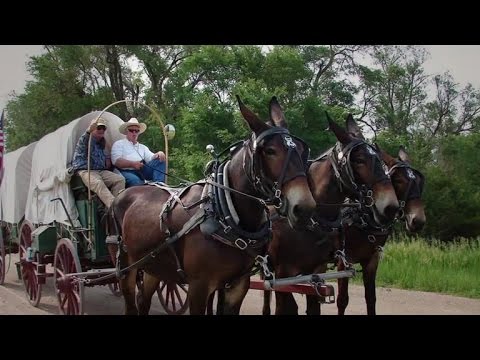Buck, Rinker. The Oregon Trail: A New American Journey, Simon and Schuster, New York, 2015 (450pp. $28.00)
Originally known by mountain men, Army scouts and commercial wagon masters as “The Great Platte River Road”, the Oregon Trail (after 1842 or so) consisted of a spidery skein of divergent ruts, paths and worn-down dirt tracks that wound here and there on both sides of the then two-mile wide Platte River (muddy, ox-bowed, meandering, sometimes flooded, dotted with quicksand) through Nebraska and eastern Wyoming. It then wandered through a series of “cutoffs” across the high deserts of western Idaho to the Bear River Valley, along the Snake River plain, and up through the Blue Mountains to Baker City, then in Oregon territory. By the time of the Civil War, more than 400,000 travelers of all sorts had made the crossing to the Willamette Valley or the Gold Country beyond the Sierra Nevada. By the early 1890’s, when the last wagon rolled west, nearly a million Americans had gone “to see the elephant”. From jumping-off points St. Joseph, Independence or Westport to the end lay two thousand miles of hope and disappointment, a journey of four months, with luck.
The trip nowadays can be made by motorcar along paved state highways, country byways, county farm roads and super Interstates, ushering the traveler in relative comfort fairly close to the original path. Equestrians, mountain man re-enactors, and modern day Pony Express riders travel closer to the original ruts, many of which have been paved over or lost to history. Up in the dusty sagebrush regions of central Wyoming, where the trail follows the Sweetwater south and west towards South Pass at the continental divide, many ruts remain plainly visible, though far from well-traveled main roads. Magazine writer, professional journalist, and accomplished equestrian Rinker Buck, made the trip along with his talented brother Nick, in a Peter Schuttler wagon assembled by hand in the Werner Wagon Works at Horton, Kansas from plans and models of wagons made in Chicago and used widely in the original migration. Harness, tack and mules were authentic too, though the GPS devices, cell phones, pick-up trucks, delivered hay, oats and vitamin supplements (for the mules), along with layovers at public corrals and rodeo grounds, are not.
Rink’s journey sounds difficult, dangerous in spots, and exhilarating all at once. Taking four months—the road was dusty, stormy, hazardous and stressful, full of adventure and misadventure both. When he writes of trail craft—as in wonderful sections about the American mule trade, mule pedigree and breeding, “mule craft”, harnessing, handling, feeding and care—the book sparkles. The same goes for long sections on wagon-craft, map reading, weather and scenery. And although the subject of the Oregon Trail has been raked over by some of America’s finest historians, Rinker manages to relate stories about pioneer life, disease, grave location and trail development and history that add to our collective knowledge. The history of “camptowns” and “public corrals in the West” bristles with new information. Who couldn’t be mesmerized hearing about Philip Ropp of Ropp’s Mule Farm in Jamesport, Missouri; or enchanted by the joint human-mule learning experience exchanged among Bute (a pigeon-toed laggard), cantankerous Beck, and hardworking but loveable Jake? Building a team was a man-mule enterprise, accomplished with expertise and patience on both sides of the genetic divide.
“The Oregon Trail” is an uneven work, despite the rigors and triumph of the core story. Driving a wagon nearly two thousand miles along ruts, farm roads, and major highways is a grand accomplishment. And Buck delivers some neglected history in spades. Other stories, like that of Narcissa Whitman, the first white woman to cross the Rockies, are chestnuts. Interrupting the book at regular (too regular) intervals are diversions into unpleasant family “psycho-history”, mainly dramas played out in Buck’s memory about his overbearing, alcoholic father. He and his brother Nick have an uneven past as well. Long, tiring sections of the book expose the tedious backdrop to their conflicts. The author renders dreadful “conversations” which supposedly occurred along the trail, dialogue full of casual profanity and vainglorious posturing, all of which clutters up the manuscript to no purpose.
“The Oregon Trail” has a number of exquisite line drawings, though it lacks a dynamic set of maps, detailed photographs, and anything but a bare-bones bibliography. The real story (deeply buried in the “Acknowledgments”) concerns the human beings who live and ranch along the Great Platte River Road today, and along the Snake River and in Baker City. Helpful Wyoming ranchers, hard-working Nebraska farmers, roadside mechanics, waitresses, cowboys, horse trainers, vets, Highway Patrolmen and members of the Oregon-California Trails Association—their help and hospitality was crucial to the success of this journey. Yes, Buck mentions them and thanks them. But a great travel writer like John McPhee, Paul Theroux, or the late Robert Byron would have made those people the real issue, relegating their personalities, gripes and grudges to the dugout. In that book we would have uncovered the backstory of Ash Hollow, Nebraska, Big Sandy Station, Wyoming, Burnt Ranch, Emigrant Springs and dozens of others and the living, breathing, beings feeding cows, raising kids, and making love within sight of the wagon ruts. Even so, Rinker and Nick deserve praise for their skill, ingenuity and fortitude. The book, marred in places, still deserves place of pride on the “Western History” bookshelf.


